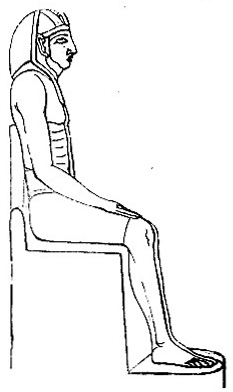Ancient Egyptian Architecture (cont.)
Statues
Connected with the temples, and forming an important part of their decorative features, were gigantic statues and obelisk. The statues are of enormous proportions. The sitting figure of Memnon is about 53 feet without the pedestal; and that in the sepulchre of Osymandyas (the Memnonium) is nearly 60 feet high. The face of Memnon is 7 feet high, and the ear 3 feet 6 inches long, and the shoulders measure nearly 26 feet across.

Fig. 23 -- Sitting Figure of Memnon.
Commentary
"Statues were another common art form Egyptians liked making. Most were of gods, goddesses, pharaohs, and queens. The statues could be made small or large. Statues were not supposed to copy nature, but they were meant to be symbols of the people's beliefs. Statues always had to be youthful figures. The paintings and drawings of Egyptian people look flat and strange, because they were painted in a particular way. Important people were painted larger than others. Heads were shown from front view. Eyes and the top half of the body were shown from the front, but arms and legs were shown from the side, so that they were easier to see." (Source: Brisas Museum)
Read the rest of this article:
Architecture - Table of Contents
